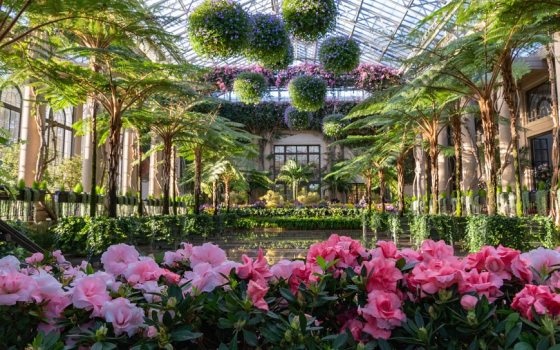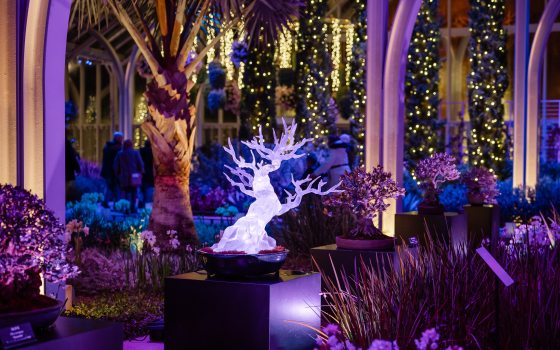With iconic, impactful, and simply gorgeous plants gracing nearly every corner of our Main and East Conservatory display, March is the time that many of our most signature plants are on view in full spectacular bloom. Whether they’re rare in the world of horticulture, of great historical significance to Longwood, or unique in the way in which we grow or display them, all of these plants are, without question, beautiful. Join me as I take you on a video and visual tour of our March highlights here in the Conservatory.
Look up and you’ll see one of Longwood’s most iconic plants floating above our Fern Floor. We’ve been adorning baskets with Streptocarpus ‘Concord Blue’ for about a decade now, and for good reason … it’s proven to be one of the longest-lasting plants we display overhead. Often called cape-primrose, this plant is a gesneriad, or a member of the African-violet family, and its delicate, vibrant blue-purple flowers are produced nearly all year long ... they take a summer break. There’s no deadheading necessary when it comes to Streptocarpus ‘Concord Blue’. I can’t recall another plant that produces this many flowers with so little input from us!

Looking for more cape-primrose beauty? Look to the planter boxes on the curved railings of the Exhibition Hall and you’ll find the seductively beautiful colors of Streptocarpus ‘Strawberry Ice’. Like Streptocarpus ‘Concord Blue’, this bright pink stunner grows in the mountainous regions of South Africa and is an easy-to-care-for houseplant when placed in bright but indirect light.
If you turn and face our Orangery, you’ll see Kohleria ‘HCY’s Peach Queen’ along our northwest walkway and Kohleria ‘Longwood’ nestled in our urns. Beloved for its peachy pink hue, Kohleria ‘HCY’s Peach Queen’ is a Taiwanese kohleria hybrid super-bloomer.
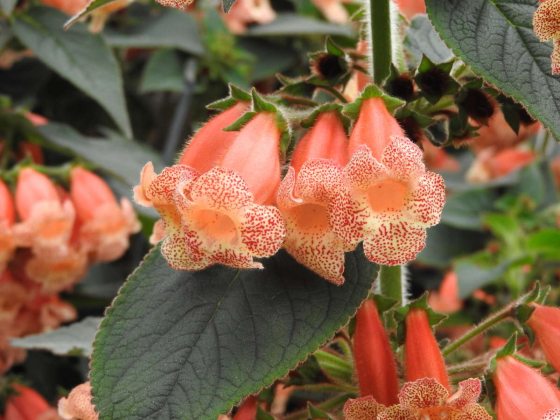
A signature cultivar collected at a botanical garden in Europe and named for us here at Longwood, Kohleria ‘Longwood’ features a deeper, richer pink-red flower. There are so many wonderfully worthy plants grown around the globe that might go unnoticed in a huge botanical collection. When we combine those understatedly lovely specimens with the rich floral diversity within our production capability, you get combinations that are complex and complementary of color and texture.

A not-to-be missed Exhibition Hall moment that will come later this March can be found courtesy of our iconic Echium candicans ‘Select Blue’. This native of the Mediterranean region is a biennial that we grow from cuttings. It takes a little more than a year to get a new cutting to the size of plant you see on display. Since these plants blossom in late winter and very early spring, they aren’t suited to be grown outdoors in our region … so we’re fortunate to be able to have their vibrant blue blooms in full glorious display in our Conservatory later this month.
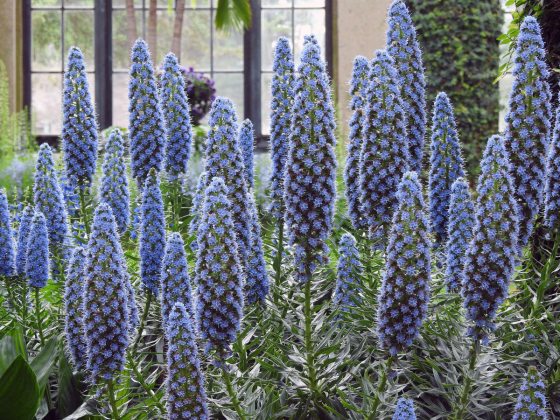
We’ve been growing Echium for several decades and the cultivar ‘Select Blue’ is an outstanding specimen of bluebird-blue as compared to the variable light to medium-blue or even pink of the species. This cutting-grown selection came from San Marcos Growers in Santa Barbara, CA and only grows outdoors in Coastal California in the United States. The fact that it’s not winter-hardy and needs such a long time to develop into the specimens you see at Longwood makes our Conservatory garden the only place you’ll see this many spectacularly-spired specimens in one place!
Also found in our Exhibition Hall, gorgeous green Cymbidium stun with their tall stems graced with many flowers. Identified by their grassy leaves, these showy orchids native to tropical and subtropical Asia and Australia are known to carry many long-lasting flowers on each stem … in fact, their flowers can last up to two months or more in the right conditions. They make fantastic houseplants if you keep your home relatively cool, as that’s what triggers the plant to flower, and cut flowers. With deep red flowers that serve as a fantastic counterpoint to the green Cymbydium, Rhodeodendron 'Scarlet' Keepsake® is a hybrid azalea. We selected this winter-hardy azalea cultivar to echo the red lip of the Cymbidium adjacent to them. Once these azaleas finish blooming inside your home they can be planted outdoors after the danger of frost is past and enjoyed for seasons to come. These plants are produced in Florida for our late-winter displays and require more than 15 months of planning to identify and produce the carpet of blossoms you see here today.
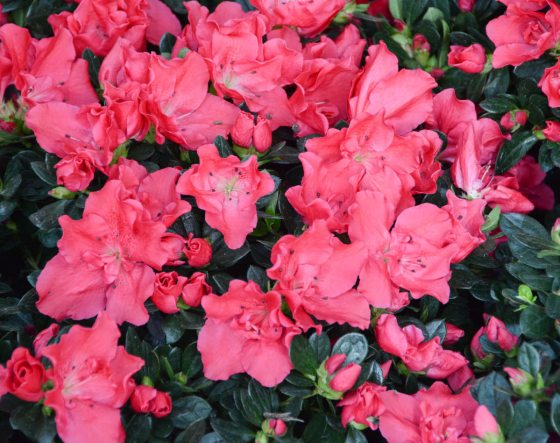
Mixed within the red azaleas and near the Cymbidium with the same scarlet lip, Dracanea marginata ‘Colorama’ offers a dramatic texture that accentuates the soft and billowy blossoms while echoing the same hue of reddish-pink. You can achieve a similar look in your outdoor gardens when mixing dwarf grasses and sedges with smaller perennials. Dracaena marginata ‘Colorama’ certainly lives up to its name. This dramatic plant comes from the asparagus family and serves as a wonderful houseplant option … we’ve chosen to elevate its beauty in basket form.
Due to be on display in our East Conservatory in late March, Genista × spachiana is a ray of sunshine with its happy yellow blooms and a reputation as an iconic plant here at Longwood. This fragrant spike is special to Longwood for the exuberant texture it lends to the Conservatory displays. Another example of a non-hardy winter growing plant from the Mediterranean region, this member of the pea family comes into flower before most things emerge in the contrasting outdoor gardens here. The glowing blossoms of clear-yellow are a welcome sight on the gray days and nearly blinding on the sunny days! You won’t see this plant very far away from the coast of California as it requires a nearly frost-free winter and a cool summer to coax the stems to the length that we display here. With such a long period of greenhouse cultivation, many growers just can’t dedicate the time and space to produce what we’re doing at Longwood Gardens.
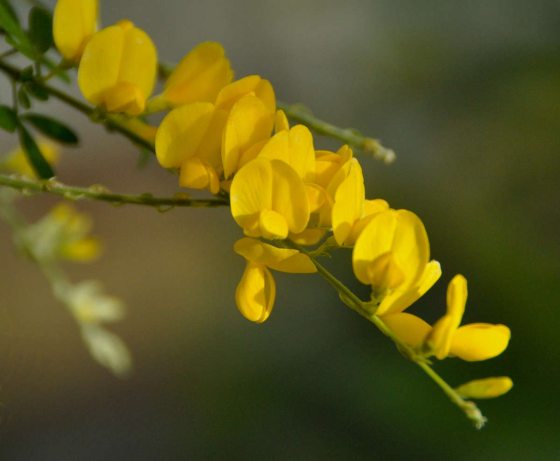
Last but certainly not least, Clerodendrum quadriloculare is a spectacular, iconic Longwood plant we happily show off in standard form. Native to the Philippines, this beautiful plant features gigantic flower clusters beautifully complemented by gray-green leaves. Here at Longwood, we elevate its display potential by training it into a standard form. I first saw this plant in 2000 on Grand Cayman growing as a 15-foot-tall shrub. Realizing that we couldn’t use something that unruly in our highly manicured Conservatory garden, we did a trial to grow the plants as a formal standard and have been doing so for the past two decades now. Careful deadheading allows us to keep the plants on display for a few weeks longer than the blooms actually last since the calyx is colorful as well.
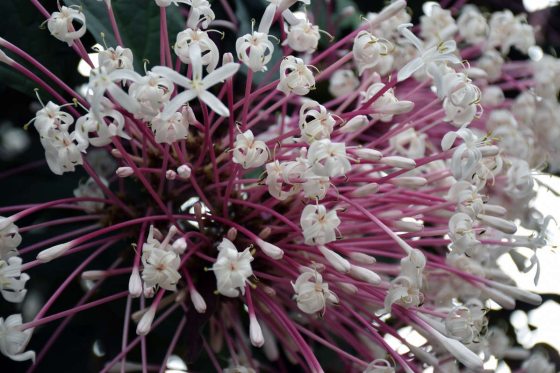
Don’t miss your chance to see these iconic, impactful, beautiful plants in person … March is the perfect time to experience their beauty! You won’t see them displayed like this anywhere else in the world, and we’re beyond delighted to be the ones to share these showstoppers with you.
